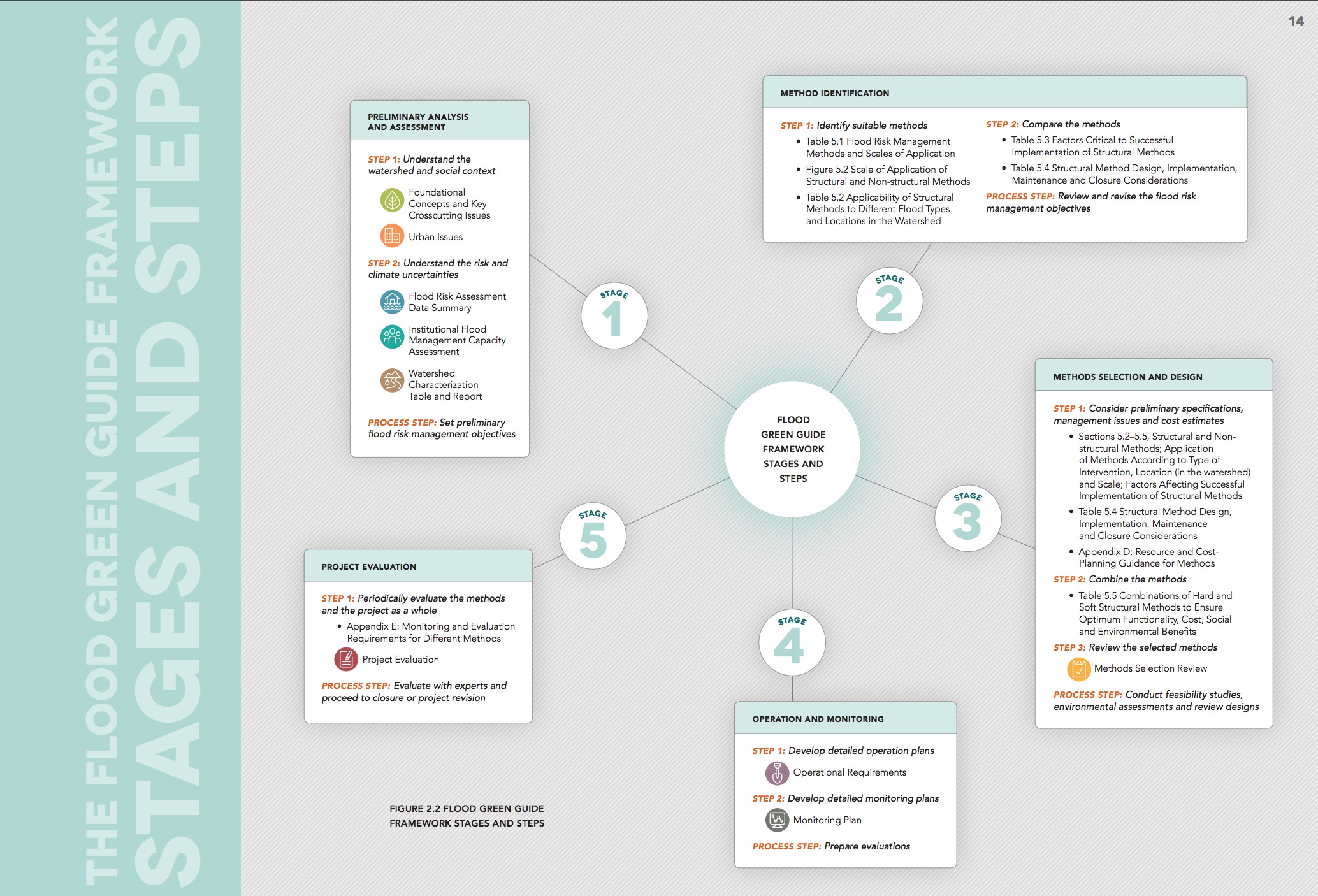WORLD WILDLIFE FUND
Introduction
 Since their earliest settlements, humans have experimented with and adopted ways to manage flood risk. Some approaches are designed to prevent, some to manage, and others to handle the impact of floods. Anyone exploring flood risk management options should understand how different methods are intended to work – and under which circumstances. The financial, social and environmental costs and benefits of various flood management interventions also should be examined.
Since their earliest settlements, humans have experimented with and adopted ways to manage flood risk. Some approaches are designed to prevent, some to manage, and others to handle the impact of floods. Anyone exploring flood risk management options should understand how different methods are intended to work – and under which circumstances. The financial, social and environmental costs and benefits of various flood management interventions also should be examined.
When communities live, work and play in areas prone to flooding, they expose themselves to flood-related damage. Human activity (such as landfill, damming and urbanization) can introduce new risks to areas previously not subjected to flooding. In both cases, flood risk can be managed by altering either the natural or physical features (such as landscape, hydraulics, vegetation) or human activities (such as land use plans and settlement locations).
The Natural and Nature-Based Flood Management: A Green Guide (Flood Green Guide) supports the concept that flood risk management measures should be comprehensive, locally specific, integrated and balanced across all concerned sectors. Therefore, the guide is based to the extent possible and practical on the integrated flood management3 (IFM) approach as defined by the Associated Programme on Flood Management (APFM):
“IFM integrates land and water resources development in a river basin, within the context of integrated water resources management, with a view to maximizing the efficient use of floodplains and to minimizing loss of life and property. Integrated flood management, like integrated water resources management, should encourage the participation of users, planners and policymakers at all levels. The approach should be open, transparent, inclusive and communicative; should require the decentralization of decision-making; and should include public consultation and the involvement of stakeholders in planning and implementation.”
For the purpose of the Flood Green Guide, we use the definitions adopted by the US Army Corps of Engineers (USACE) to describe natural features as those created through the action of physical, biological, geologic, and chemical processes operating in nature, whereas nature-based features are created by human design, engineering and construction.
Throughout the guide, we use the terms “natural“ and “nature-based“ interchangeably. We also recognize that in some cases, practitioners may use other terms, such as “green” or “green infrastructure,” interchangeably with the terms natural and nature-based.
The Flood Green Guide organizes flood management methods into two categories: structural and non-structural. Structural methods involve physical changes to natural features or human infrastructure, including engineered (hard) methods (sometimes referred to as gray methods), such as dams or floodways, and natural and nature-based (soft) methods (sometimes referred to as green methods), such as wetland protection, upper watershed restoration or rain gardens.
Non-structural measures are defined as those that seek to change social conventions like laws, regulations, social institutions, organizations or individual behavior. Most flood risk management projects will comprise both structural (hard and soft methods) and non-structural components. In the Flood Green Guide, we recommend the use of a combination of multiple methods of hard and soft, structural and non-structural approaches that complement one another and enhance the efficacy of any existing flood risk management methods. In most cases, a combination of methods will be required and, therefore, the use of a single approach in isolation is not advised. Chapter 5 of the guide discusses in detail a comprehensive list of structural and non-structural flood risk management methods.
The “How to Use the Flood Green Guide” chapter leads those responsible for flood management (referred to as managers or guide users) through information gathering, analysis, and decision-making at multiple stages of a typical flood risk management project cycle.
The Flood Green Guide is organized into the following chapters:
Chapter 1. Introduction
This chapter explains the objective and organization of the Flood Green Guide.
Chapter 2. How to Use the Flood Green Guide
This chapter explains how to follow a project management cycle to conduct preliminary analysis and set goals and objectives based on an understanding of context and risk; identify a range of suitable flood management methods; select specific methods; determine operation and monitoring plans; and conduct evaluation of the strategies implemented. The entire process is meant to be continual and circular; thus, the system should be regularly updated as described in this chapter.
Chapter 3. Foundational Concepts and Key Crosscutting Issues
This chapter explains the key elements to understanding the context in which flood risk management takes place. Topics covered include flood definitions, causes, benefits and hazards; watershed systems and characteristics; the water cycle and managing water; and climate, climate variability and weather. This chapter also discusses key crosscutting issues relevant to flood risk management, including institutions, regulations, cross-sector coordination and cooperation, community engagement, gender, private sector, finances and funding.
Chapter 4. Assessing Flood Risk: Data, Methods, and Analysis
This chapter covers elements involved in assessing flood risk. Understanding flood risk is critical to planning and selecting the appropriate risk management options presented in chapter 5. This chapter reviews flood risk management needs and sources, followed by a simple way to understand the nature of watersheds. Since a wide range of risk assessment techniques and tools are currently available to the Flood Green Guide user, this chapter focuses on the results that a risk assessment should produce, and how these results can be used to select flood management methods. The chapter closes with a method to assess institutional capacities to manage flood risk, a key consideration in deciding on the most appropriate combination of management methods.
Chapter 5. Structural and Non-structural Methods
This chapter discusses the structural and non-structural methods for flood management based on an integrated flood management (IFM) approach. Flooding has consequences at multiple levels, including national/regional, watershed, floodplain, community and household. Therefore, this chapter discusses management methods that should be selected based on the specific requirements at different scales. This guide does not advise the use of a single flood risk management method in isolation. A combination of integrated structural – both hard and soft – and non-structural methods is recommended as the optimum approach, one that will enhance the efficacy of existing flood risk management methods. The remainder of this chapter introduces different flood risk management methods, offering essential design and selection criteria, and comparative costs and benefits.
Chapter 6. Urban Issues
This chapter describes issues unique to urban areas, including the nature of flooding, the impacts of climate, urban flood governance, and considerations for urban coastal areas. Urbanization amplifies flood risk and increases the frequency of localized floods, and urban coastal areas face the additional threat of rising seas. The differences between urban and rural floods are not often distinguished; there is no common definition for what constitutes an urban area. Given the severity and expense of urban flood impacts, however, we highlight some key issues related to flooding in urban areas that the Flood Green Guide user should consider when using the guide in urban areas.
Download full version (PDF): Natural and Nature-Based Flood Management
About the World Wildlife Fund
www.worldwildlife.org
For 50 years, WWF has been protecting the future of nature.The world’s leading conservation organization, WWF works in 100 countries and is supported by more than one million members in the United States and close to five million globally. WWF’s unique way of working combines global reach with a foundation in science, involves action at every level from local to global, and ensures the delivery of innovative solutions that meet the needs of both people and nature.
Tags: Flood Management, Flooding, Floods, Green Infrastructure, World Wildlife Fund, WWF







 RSS Feed
RSS Feed